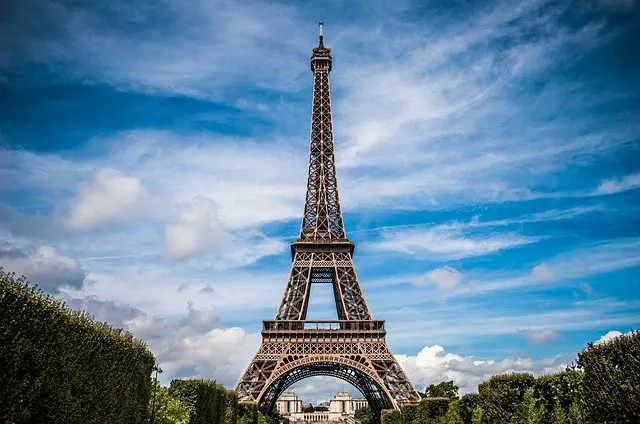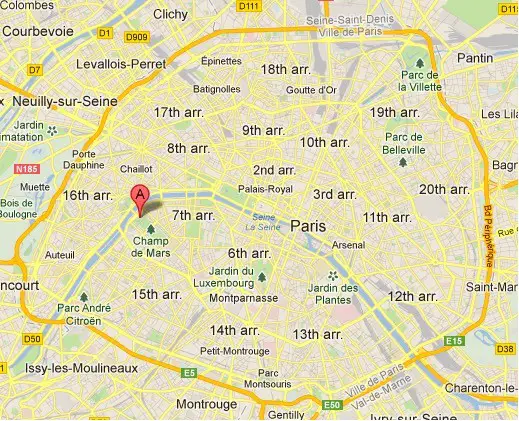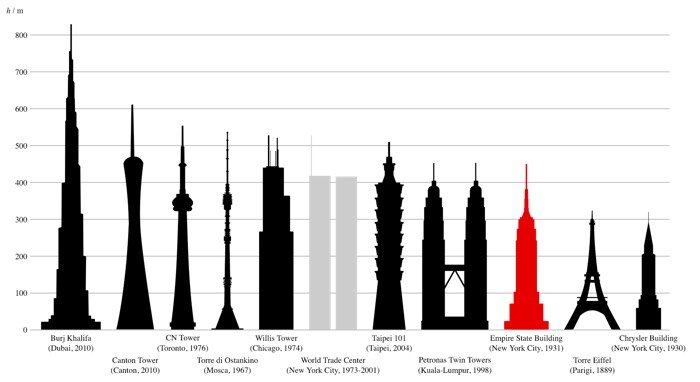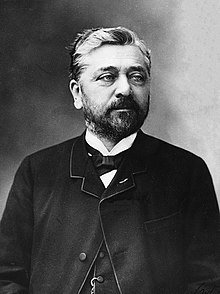Many of the manmade landmarks in the world have become a symbol of representation for the country or city where they are made. Eiffel tower is one of such manmade landmarks. Whenever we think of Paris the Eiffel tower always comes to mind and vice versa. We have gathered a complete set of Eiffel Tower Facts For Kids that will provide you with all the Eiffel Tower Information you need to know. You are going to learn about its description, its name, what it represents, location, history, measurements, why it was made, its importance, the architect, construction, and many interesting facts about the Eiffel Tower.
Eiffel Tower Facts For Kids
1. What Is The Eiffel Tower
- Eiffel tower is one of the most iconic landmarks in Paris.
- It is a tower based on an iron model and located in Champ de Mars, France.
- It has been a symbol of national heritage for France for a decade.

2. Eiffel Tower Description
- The Eiffel tower is a stylish tower that stands on four pillars on the ground.
- The material used to make this tower is wrought iron which has is tough, malleable, ductile, and corrosion-resistant.
- Its shape resembles the pyramids of Egypt, however, its sides are slightly curved.
- The Eiffel tower has been painted 18 times since its construction.
- The Eiffel tower is called La Tour Eiffel in French.
- At the World’s Fair of 1889, the Eiffel tower was declared one of the most significant monuments in the world.
- Today, the Eiffel tower plays a significant role in the broadcasting of radio and television.
3. Who Is The Eiffel Tower Named After – Eiffel Tower Meaning
- Eiffel tower is named after the French civil engineer, Alexandre Gustave Eiffel.
- It was designed and built by his company for the Paris Exhibition of 1889.
4. Eiffel Tower Nickname
- The nickname of the Eiffel tower is “La dame de fer” which translates to “Iron lady”.
5. What Does The Eiffel Tower Represent
- The Eiffel Tower is a symbol of the city of Paris and France. It works as a communication representative of France.
- The Eiffel Tower was the main exhibit of the Paris Exposition in 1889.
- It was erected to symbolize the centennial of the French Revolution. It was also a symbol of France’s industrial prowess for the whole world.
6. Where Is The Eiffel Tower Located – Eiffel Tower Location
- The Eiffel Tower is in the city of Paris, France.
- It is located in the 7th arrondissement on the banks of river Seine, in the center of Paris.
- Its exact location is between the fields of Mars in the South and Trocadero in the North, whereas the river Seine is separating the Trocadero from the tower.

Eiffel Tower Position
- Its exact GPS coordinates are 48°51’30.13” North and 2°17’40.13” East.
7. Eiffel Tower Background facts for Kids
- For the International Exposition in 1885, France was planning to celebrate the 100th anniversary of the French Revolution and the birth of democracy by building an impressive monument.
- Many design proposals were submitted in a competition held by the commissioner at a fair. He chose Gustave Eiffel’s design, but it was so controversial that a petition was signed by over 300 people protesting its construction.
- This tower was constructed using Eiffel’s mathematical calculations, but some detractors were worried about safety, despite the security features in the design such as guard rails and screens.
- In 1909, the Eiffel Tower was about to be destroyed but was spared because its high antenna could be used for military purposes. In fact, during World War I, the radio antenna of the Eiffel Tower played a vital role in capturing the notorious spy – Mata Hari.
- The Eiffel Tower was the tallest man-made structure in the world till 1930. This French landmark was visited by more than 200 million people since it was first erected in 1889.
8. When Was The Eiffel Tower Built – What Year Was The Eiffel Tower Built
- The construction of the Eiffel Tower started on January 28, 1887.
- It was completed on March 31, 1889, and was inaugurated in the same year.
9. How Old Is The Eiffel Tower
- The Eiffel tower is 131 years old.
10. Who Gave France The Eiffel Tower
 Gustave Eiffel – a French civil engineer and designer gave the Eiffel Tower to France. It is a premier tourist destination.
Gustave Eiffel – a French civil engineer and designer gave the Eiffel Tower to France. It is a premier tourist destination.- On the Eiffel Tower, seventy-two French scientists, engineers, and other notable people were engraved by Gustave Eiffel in recognition of their contributions.
- 107 bids were submitted for the construction of the Eiffel Tower. 50 people worked on designing the tower, and more than 100 worked together to build the parts.
11. How Big Is The Eiffel Tower – Eiffel Tower Size
- Eiffel tower was the tallest structure of its time in the whole world.
- Its proposed height was about 300 meters with 125 meters sides.
- When it was completed in 1889, it replaced the Washington Monument as the tallest man-built structure in the whole world.
- Eiffel tower retained the title of the tallest structure in the world till 1930 when Chrysler Building (319 meters) was completed in New York City.
- In the year 1902, the Eiffel tower was struck by lightning. This caused the reconstruction of the top 300 feet of the tower and the replacement of the lights illuminating the tower.
12. How Tall Is The Eiffel Tower – Eiffel Tower Height – How High Is The Eiffel Tower
- The Eiffel Tower is the second-highest structure in France. The highest structure in France is the Allouis longwave transmitter, built-in 1930, with a height of 350 meters.
- However, in Paris, the highest structure is the Eiffel Tower. The second-highest structure after the Eiffel Tower is the Tour Montparnasse (Montparnasse Tower), with a height of 210 meters.
How Tall Is The Eiffel Tower In Feet – Eiffel Tower Height In Feet
- The height of the Eiffel Tower is 1000 ft. With the 70 ft antenna on top of the tower, the total height is 1070 ft, which is about 81 stories high.
How Tall Is The Eiffel Tower In Meters
- The height of the Eiffel Tower is 300 meters. With the 20.75 meters antenna on top of the tower, the total height is 320.75 meters.

13. How Much Does The Eiffel Tower Weigh – How Heavy Is The Eiffel Tower
- The total weight of the Eiffel Tower is 10,100 tons, out of which the iron structure weighs 7,300 tons.
14. Eiffel Tower Measurements – Eiffel Tower Dimensions
- The height of the Eiffel Tower is 1000 ft. With the 70 ft antenna on top of the tower, the total height is 1070 ft, which is about 81 stories high.
- There are three platforms on the Eiffel Tower. Their dimensions are given below:
- First Platform
- Height – 57.63 meters
- Surface Area – 4200 m²
- External Width – 70.69 meters
- Second Platform
- Height – 115.73 meters
- Surface Area – 1650 m²
- External Width – 40.96 meters
- Third Platform
- Height – 276.13
- Surface Area – 350 m²
- External Width – 18.65 meters
- First Platform
- The arch at the bottom of the tower is 74.24 meters wide. It has tempted many pilots to fly a plane through the arch.
- The base of the Eiffel Tower lies 33.5 meters above sea level.
15. How Many Stories Is The Eiffel Tower – How Many Floors Is The Eiffel Tower
- There are three floors in the Eiffel Tower. However, the height of the Eiffel Tower is equivalent to that of a building with 81 stories.
- The most interesting and modern floor among these is the first floor. It was re-built in 2011, hence all the modern facilities are available here.
- The second floor of the Eiffel Tower is the least interesting. It has neither been re-built nor renovated since the 19th century, hence its style matches that era. This is the most commercial floor among the three, with many shops.
16. How Many Steps In The Eiffel Tower
- The number of steps to the top of the Eiffel has varied over time through various renovations. During the initial construction, there were 1710 steps to the top which is at a height of 300.65 meters. The steps became 1920 after the renovation in the early 1980s, but now there are a total of 1665 steps.
17. Why Was The Eiffel Tower Made
- In 1851, the first universal exposition took place in London. Many countries participated in this exposition and wanted to display their technological advances and industrial progress to the whole world.
- The Universal Exposition was hosted again in 1855, 1867, and 1878. Then, it was planned to be hosted in France in 1889.
- A fair was held in France which invited different engineers to present their plans to build a magnificent building for the Universal Exposition of 1889.
- Gustave Eiffel decided to present the idea of the Eiffel Tower for the Paris Exhibition of 1889.
- The Eiffel Tower project was started by two engineers in 1884. Gustave Eiffel presented his project at a fair and won the competition against other several projects. The construction of the project started in July 1887 and it was completed just before the beginning of the universal exposition in March 1889.
18. Why Is The Eiffel Tower Important – Importance Of Eiffel Tower
- The Eiffel Tower is a symbol of LOVE.
- It plays an important role in television and radio broadcasts.
- It is considered an architectural wonder and attracts more visitors than any other paid tourist attraction in the world.
- The Eiffel tower is a symbolic representation of modern science. It is a magnificent art of modern engineering.
- It is not just a tourist attraction. There is a newspaper office, post office, scientific laboratories, and a theater in the Eiffel Tower. Also, the first level of the Eiffel Tower becomes an ice rink every winter.
19. Why Is The Eiffel Tower Famous
- The Eiffel Tower is famous because it was designed only for the Exposition Universelle. It wasn’t intended to stay there and was to be destroyed just like many other buildings that were constructed for the Exhibition and were destroyed later. The Eiffel Tower became so popular and looked so amazing that they decided to let it stay, while the other buildings were destroyed.
- It is also famous because it is unique and doesn’t look like anything else in the whole world. We can get an insane view of the city of Paris from the top of the Eiffel Tower.
- The Eiffel Tower represents the industrial era of France to the whole world.
- Many artists, who filmed the Eiffel Tower and wrote about it also made it popular.
20. What Is The Eiffel Tower Used For
- The Eiffel Tower has been used for radio transmission since the beginning of the 20th century. A set of antenna wires from the Champ de Mars and Avenue de Suffren are connected to the top of the Eiffel Tower. These wires are linked to long-wave transmitters in small bunkers. An underground radio center was built near the south pillar in 1909, which still exists.
- The Eiffel tower was also used by the Germans for television broadcasts during the German occupation of Paris from 1940 to 1944. These television broadcasts were mainly intended for wounded soldiers that were being treated in the local military hospitals.
21. Eiffel Tower History – Eiffel Tower Story
- Paris was one of the most popular tourist places in the world.
- A competition was organized to commemorate the centennial of the French Revolution, which was aimed at building an iron tower with a square base on Champ-de-Mars. The tower was to be 300 meters high and its base was supposed to be 125 meters wide.
- A total of 107 proposals were submitted in this competition. Gustave Eiffel’s (a French Civil Engineer and Architect) idea dominated the other submissions and was chosen as the winner. He was assigned the task to build and erecting the tower in Paris.
- There was a lot of resistance by some of the local people against the construction of the Eiffel Tower. They wrote a letter titled “Artists Against Mr. Eiffel’s Tower”, in which they declared the tower as a threat to the aesthetic nature of Paris. They stated that an iron tower in the heart of Paris would harm the elegance and beauty of the city. They named the tower “Skeleton of Beffroi” to demonstrate its contrast with the beauty of Paris.
- However, the Eiffel Tower was still constructed despite this resistance.
- It was constructed in different steps:
- The project drawings were made in June 1884.
- The work on construction started on 28th January 1887.
- The first stage was completed on 1st April 1888.
- The second stage was completed on 14th August 1888.
- The third stage was completed on 31st March 1889. This was the final stage and the construction of the Eiffel Tower finished.
- The inauguration of the Eiffel Tower took place on 31st March 1889. Gustave Eiffel climbed the 1,710 steps to the top and hoisted the French flag at a height of 312 meters.
22. Who Designed The Eiffel Tower – Eiffel Tower Architect Facts for Kids
- Although the Eiffel Tower is named after Gustave Eiffel, it was initially designed by Gustave Eiffel’s three employees.
- These three employees were:
- Emile Nouguier – Office Manager
- Maurice Koechlin – Engineer
- Stephen Sauvestre – Achitect
- The initial sketches and calculations were made collaboratively by these three employees.
- Stephen Sauvestre was responsible for designing the tower in such a way that it appealed not only to the public but to Gustave Eiffel himself.
23. Who Made The Eiffel Tower – Who Built The Eiffel Tower
- The Eiffel Tower was made by Gustave Eiffel’s construction company.
25. How Long Did It Take To Build The Eiffel Tower
- The work on the construction of the Eiffel Tower was started on 26 January 1887.
- It was finished on 31 March 1889.
- The Eiffel Tower was built over a time of only 2 years, 2 months, and 5 days.
26. When Was The Eiffel Tower Finished
- The construction of the Eiffel Tower was finished on 31 March 1889.
27. How Much Did It Cost To Build The Eiffel Tower
- The total money spent on the construction of the Eiffel Tower was about 8 million francs in 1889, which is roughly equivalent to 40 million US dollars in modern currency.
28. Why Was The Eiffel Tower Built – Eiffel Tower Purpose
- The Eiffel Tower was built for the Universal Exposition of 1889, which was held in France.
- It was built as a centerpiece of the exposition and to mark the centennial of the French Revolution.
29. What Is The Eiffel Tower Made Of
- The Eiffel Tower was built using Wrought Iron, unlike many modern buildings which are built using steel.
- It was built using latticework construction, which supports its weight. There are strips of metal that have crisscrossed as the tower goes up, supporting its weight.
- Gustave Eiffel chose Iron instead of Steel because he was confident and more experienced in building iron structures.
30. How Was The Eiffel Tower Built – Eiffel Tower Construction
The Eiffel Tower was constructed floor by floor in different steps.
- The work on building the Eiffel Tower was started on 26 January 1887. The initial foundations were laid which took the workers almost 4 months.
- All the parts of the Eiffel Tower were made in Gustave Eiffel’s factory, Levallois-Perret, located on the outskirts of Paris. A total of 18,000 elementary parts were built which were all used to construct the tower according to the plans. Each part was individually designed with calculations to an accuracy of one-tenth of a millimeter, which was put together to form larger parts measuring five meters each.
- All the metallic parts of the tower were fixed by using the technique of Riveting:
- Initially, all the pieces were assembled using bolts on the site.
- These bolts were later replaced one by one with rivets, which contracted upon cooling and ensured a tight fit.
- Each rivet was assembled by four men: one heated the rivet, second to hold it in place of insertion, third to shape the head, and the fourth to beat it with a sledgehammer.
- A total of 2.5 million rivets were used in the construction of the Eiffel Tower, out of which only one-third of the total were inserted directly on site.
- The first floor of the Eiffel Tower was built using 12 temporary wooden scaffolds (30 meters high) and four larger scaffolds (45 meters high). The feet were positioned using hydraulic jacks.
- The second floor was built with the help of cranes. These cranes took the same path as those of the elevators and the workers riveted and assembled all the parts on site.
- The third floor was built in a way similar to the second floor and there were no casualties during this stage.
- After the summit of the Eiffel Tower was built, its construction was finished and it was inaugurated on 31 March 1889 by Gustave Eiffel himself.
- The Eiffel Tower was built in a record time of 2 years, 2 months, and 5 days. It was a marvel of precision and accuracy considering the time during which it was built.
- A list of some of the resources utilized in building the Eiffel Tower is given below:
- Metal Parts – 18,038
- Workshop Drawings – 5,300
- Engineers and Draughtsmen – 150 on Factory/150 to 300 on-site
- Rivets – 2,500,000
- Iron – 7,300 tonnes
- Paint – 60 tonnes
31. How Many People Died Building The Eiffel Tower
- No lives were lost on-site during the construction of the Eiffel Tower.
- Only one man lost his life while the construction of the tower was going on, but he wasn’t on duty.
- The only other casualty related to Eiffel Tower was in 1912 when a man named Franz Reichelt jumped from the first floor of Eiffel Tower to try his flying parachute suit, which was shaped like a bat. The parachute failed to open and the man died after a free fall.
32. Eiffel Tower Inside
- The floor inside the Eiffel Tower on the 1st floor is transparent. It is 57 meters high from the ground, which gives the sensation of stepping into a void to its visitors.
- 7 projectors project the different aspects of the Eiffel Tower onto 3 walls. There are many screens, displays, digital albums, and reproduced items that allow the visitors to find out about all the different aspects of the Eiffel Tower.
- There are various places for resting and meditation, restaurants and shops in the Eiffel Tower.
- There is a little character dressed as Gustave Eiffel, who guides the children and enhances their experience through signs at each stage of the tour of the Eiffel Tower.
33. Names On Eiffel Tower
- Gustave Eiffel has engraved the names of 72 French scientists, engineers, mathematicians, and other notable people as a tribute to their contributions. They are located on the sides of the tower below the first balcony.
- Most of these notable people were active during the French Revolution during the early 19th century. Some of the most prominent among them are Fourier, Foucalt, and Monge Gay-Lussac.
- There are no women on the list of these 72 notable people. It has been criticized for excluding the name of Sophie Germain, who was a French mathematician and contributed greatly to the theory of elasticity, which was crucial for the construction of the Eiffel Tower itself.
- These engravings were covered before painting the tower at the beginning of the 20th century. They were restored for the first time in 1986 by the organization that runs the site, Société Nouvelle d’exploitation de la Tour Eiffel.
The List Of Scientists
Here is a complete list of all the scientists, mathematicians and notable people whose names are engraved on the Eiffel Tower:
| Petiet | Chasles | Polonceau | Carnot | Carnot |
| Daguerre | Lavoisier | Dumas | Lamé | Lamé |
| Wurtz | Ampère | Clapeyron | Cauchy | Cauchy |
| Le Verrier | Chevreul | Borda | Belgrand | Belgrand |
| Perdonnet | Flachat | Fourier | Regnault | Regnault |
| Delambre | Navier | Bichat | Fresnel | Fresnel |
| Malus | Legendre | Sauvage | De Prony | De Prony |
| Breguet | Thénard | Pelouze | Vicat | Vicat |
| Carnot | Arago | Schneider | Ebelmen | Delaunay |
| Lamé | Poisson | Le Chatelier | Vicat | Morin |
| Cauchy | Monge | Berthier | Ebelmen | Haüy |
| Belgrand | Jamin | Barral | Coulomb | Combes |
| Regnault | Gay-Lussac | De Dion | Poinsot | De Prony |
| Fresnel | Fizeau | Goüin | Foucault | Broca |
| Becquerel | Cail | Jousselin | Cuvier | Lagrange |
| Coriolis | Triger | Poncelet | Laplace | Belanger |
| Seguin | Giffard | Bresse | Dulong | Perrier |
| Lalande | Tresca | Sturm |
34. Eiffel Tower Elevator
- The Eiffel Tower has two different elevators.
- The first elevator can take you up to the second floor. From there, the second elevator can take you to the top floor of the Eiffel Tower.
- The Eiffel Tower has had elevators since the day it was constructed in June 1889.
- The first-ever elevators used in the Eiffel Tower were hydraulic elevators. Five elevators were installed into the four pillars which could go up to the 2nd floor. These elevators were further modernized by Gustave Eiffel in 1900.
35. How Many Tourists Visit The Eiffel Tower Each Year
- The Eiffel Tower is visited by more than 7 million people every year. 75% of these visitors are from foreign countries.
- It is the most visited among the paid tourist sites in the world.
- In 1889, 250 million people from all around the world joined the inauguration ceremony of the Eiffel Tower.
36. Eiffel Tower Tickets
- The Eiffel Tower tickets cost differently depending upon the age of the visitor, the floor he/she will visit, and whether he/she will use the elevator or not.
- The tickets for climbing the Eiffel Tower through elevators can be reserved online for reserved time slots without any extra or hidden charges. They can be booked up to three months in advance. However, the tickets for climbing up to the second floor of the tower through stairs can’t be bought online and must be bought from the ticket office at the time of the visit.
- The ticket costs are given below:
- Stairs to the second floor
- 4 to 11 years – 3 euros
- 12 to 24 years – 5 euros
- 24+ years – 7 euros
- Elevator to the second floor
- 4 to 11 years – 4 euros
- 12 to 24 years – 8.50 euros
- 24+ years – 11 euros
- Elevator to the third floor
- Less than 4 years – Free
- 4 to 11 years – 8 euros
- 12 to 24 years – 14.50 euros
- 24+ years – 17 euros
- Stairs to the second floor
37. Eiffel Tower Fun Facts for Kids
- The nickname of the Eiffel tower is “La dame de fer” which translates to “Iron lady”.
- A total of 18,000 elementary parts were built which were all used to construct the Eiffel Tower. Each part was individually designed with calculations to an accuracy of one-tenth of a millimeter.
- The Eiffel Tower was built in a record time of 2 years, 2 months, and 5 days. It was a marvel of precision and accuracy considering the time during which it was built.
- No lives were lost on-site during the construction of the Eiffel Tower.
- The Eiffel Tower wasn’t intended to be a permanent structure and was to be demolished after the Universal Exposition in 1889. However, it stayed because it could act as a giant radio antenna.
- The total weight of the Eiffel Tower is 10,100 tons, out of which the iron structure weighs 7,300 tons.
- The Eiffel tower has been painted 18 times since its construction.
- The Eiffel Tower was the tallest man-made structure in the world till 1930.
- The height of the Eiffel Tower is 1000 ft. With the 70 ft antenna on top of the tower, the total height is 1070 ft, which is about 81 stories high.
- There are more than 20,000 light bulbs on the Eiffel Tower.
- The weight of paint used on the Eiffel Tower is equal to that of 10 elephants.
- There are more than 30 replicas of the Eiffel Tower around the world.
- The Eiffel Tower has been greatly criticized for not containing the names of any women among the 72 names of the scientists and notable people who have been engraved on the tower in recognition of their contributions to science and this world.
- When Adolf Hitler visited Paris during World War II, the French cut the elevator cables on the Eiffel Tower, so that he would have to climb the stairs if he wanted to get to the top.
- The Eiffel Tower was sold to a scrap metal dealer by a con artist named Victor Lustig.
- The height of the Eiffel Tower can change up to 5.9 inches due to a temperature change.
- In 1912, a man named Franz Reichelt jumped from the first floor of the Eiffel Tower to try his flying parachute suit, which was shaped like a bat. The parachute failed to open and the man died after a free fall.

 Gustave Eiffel – a French civil engineer and designer gave the Eiffel Tower to France. It is a premier tourist destination.
Gustave Eiffel Рa French civil engineer and designer gave the Eiffel Tower to France. It is a premier tourist destination.



